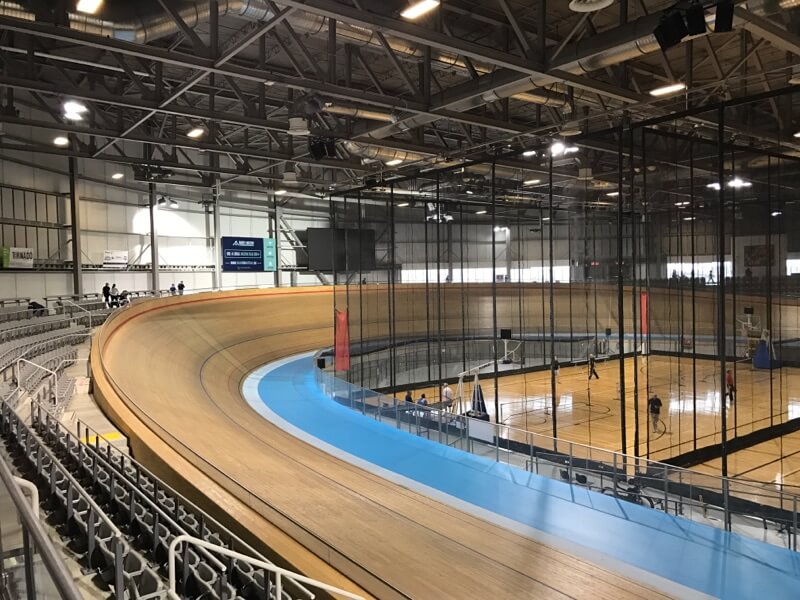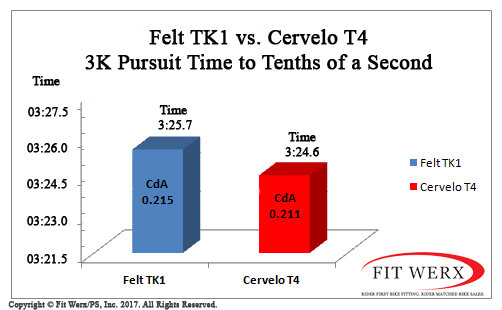Relentless Pursuit of Cycling Aerodynamics – Part 3. Track Bike Aero Test.
I recently had the opportunity to use the cutting edge Alphamantis Track Aero System (TAS) at the Mattamy National Cycling Center in Milton, Ontario. The TAS provides real-time aerodynamic data to the tester while riding, which facilitates faster on-the-spot results and decisions compared to my normal field testing routine. With anticipation and excitement, Marty and I both made the drive over the border.
Missy Erickson from ERO Sports provided the testing services and she did a great job. It is always nice to have a world class cyclist who is well-versed in equipment and testing assisting. Marty and

I provided a number of tests we wanted to perform ahead of time, and Missy helped create a game plan that would make the most effective use of time.
I have two big questions that I want answers over the past two track seasons. While I can (and do) test many things in the field, it is not easy to test track frames and track wheels in any place other than a velodrome. With this in mind, I want to first know which wheels are fastest for me and second which frame is fastest for me on the track.
Heavyweight Bout Number 1 – Mavic Comete Double Disc vs. Zipp 808/Super9
I’ve searched and asked around extensively, but there are no published test results showing how the “fastest time trial wheel” (Zipp 808/Super9) compares against the “fastest track wheel” (Mavic Comete Disc). This question needs an answer.
I’ve run the Zipp 808/Super9 carbon clinchers with the now out-of-production Continental Supersonic 700×23 tires with latex tubes for all outdoor track races the past three seasons. I also used this setup at the indoor Masters Track Worlds in 2015. There is no question this is a fast setup.
However, wat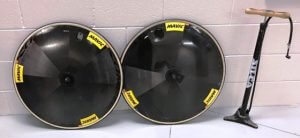 ch any world class track event (like Hour Record attempts) and you’ll see more Mavic Comete disc setups used than any other wheels. And, if you look closer, you’ll see the super smooth 19mm Vittoria Pista tubular tires on nearly all of them. In a sport that tests everything, and where thousandths of a second can matter, the Mavic Comete double disc has won more Olympic medals than any other wheelset in history. I was so convinced by the sheer volume of world class athletes ridding on the Mavics, that I ran them at the masters track worlds last year.
ch any world class track event (like Hour Record attempts) and you’ll see more Mavic Comete disc setups used than any other wheels. And, if you look closer, you’ll see the super smooth 19mm Vittoria Pista tubular tires on nearly all of them. In a sport that tests everything, and where thousandths of a second can matter, the Mavic Comete double disc has won more Olympic medals than any other wheelset in history. I was so convinced by the sheer volume of world class athletes ridding on the Mavics, that I ran them at the masters track worlds last year.
Wheel Aero Testing Controls for the Velodrome
To test the wheels accurately, I made sure I had speed sensor magnets lined up in the same place on both wheelsets, and I accounted for the tire circumference difference. I also recorded lap splits as a back up in the testing data if I needed them. Why? I start losing trust in wheel speed data when the wheel is always leaning at different angles in velodrome turns as it changes the effective tire circumference contacting the track. An article for another day… With these controls in place, it was time to see if a clear winner could be determined.
Heavyweight Bout Number 2 – Felt TK1 vs. Cervelo T4 Track Frames
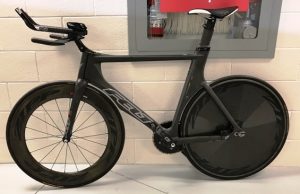
You would think there would be published aero tests comparing these two benchmark track frames against each other somewhere on the internet. You would think… There isn’t. This is a test I have wanted to do for a long time and I’m happy to publish the first results of this heavyweight showdown in this article. As an added bonus for me, the results are specific to me and my other equipment. It doesn’t get any more accurate for deciding what equipment is fastest for the individual than testing it with the individual in a real world environment. Yes, field testing like this is better than a trip to the wind tunnel.
A little background on the contenders and why I didn’t do this test years earlier. When I built my first track bike, I couldn’t get the saddle on the Cervelo T4 to go far enough back in the seatpost to match my time trial position. This made my decision for which world-beating track frame to go with easy as the Felt could match my position and the Cervelo could not. As we all know – compromising your position to accommodate for equipment is almost never a good idea. I won a number of national and world titles on the Felt in the p
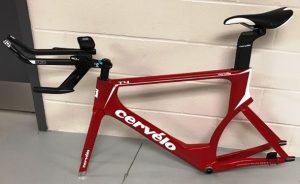
ast two seasons and have seen it under more serious track cyclists than any other frame. I have never been disappointed by the performance of the Felt TK1.
However, any athlete who can find an improvement should take it. When Cervelo came out with a new seatpost option made that would allow me to match my posi
tion on the Cervelo T4, I knew I had to find a way to test both bikes.
Frame Aero Testing Controls for the Velodrome
While testing two frames sounds simple, it took a lot of planning and controls. I made sure to use the same SRM power meter on both bikes to eliminate any drift between units and this necessitated changing the crank at the track. I also swapped the same track chain between bikes to eliminate frictional difference and I purchased a second Shimano Pro Missile aerobar so I
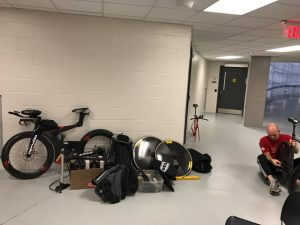
could have it set up exactly the same on both bikes. I rode both bikes back and forth in the weeks leading up to the testing to make sure everything was running perfectly on both. I rehearsed swapping the SRM and chain back and forth to minimize time spent making changes. These swaps would have to be done trackside while still wearing my aero helmet and tight skinsuit. I am confident that I eliminated as many variables as possible and that my results are clean and solid.
Undercard Bout – Shimano Pro Missile Aerobar vs USE Tula Track Aerobar
The only aerobar in the world rumored to have a lower CdA than the Shimano Pro Missile aerobar is the USE Tula Track Aerobar. So, I ordered one of these and set it to match my exact UCI legal position. If time allowed, I’d swap it onto the bike and test as well.
Velodrome Equipment Testing Aerodynamics Results
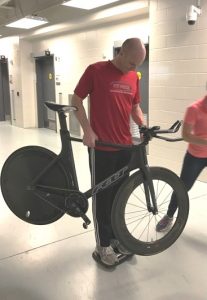
It was time to roll. We warmed up on the track. Marty and I would rotate between runs. While one of us was testing the other was making equipment changes. A setup test is 12 laps of the 250 meter velodrome, which takes about four minutes. The testing and equipment changes thankfully went smoothly. I was even able to complete the SRM swap before Marty finished his run. Below are the drag results on my seven sessions:
Session 1: Felt TK1 w/Mavic/Shimano. My baseline setup from Worlds – CdA 0.220
Session 2: Felt TK1 w/ Zipp/Shimano. – CdA 0.215
Session 3: Felt TK1 w/Mavic/Shimano (Repeat of Session 1) – CdA 0.222
Session 4: Cervelo T4 w/Zipp/Shimano – 0.211
Session 5: Cervelo T4 w/Zipp/Shimano (Repeat of Session 4) – 0.211
Session 6: Cervelo T4 w/Zipp/USE – 0.211
Session 7: Cervelo T4 w/Zipp/USE (Repeat of Session 6) – 0.211
Why the repeats? The repeat setups are done to account for a number of factors that can influence results. These include:
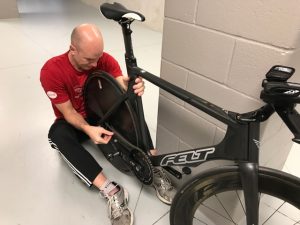
- Rider fatigue resulting in position changing.
- Clothing and helmets moving during testing.
- Power meter calibration values changing.
- Track conditions changing with varying temperature and pressure throughout the afternoon.
- Pilot error following the black line around the track throughout the testing.
- Power and speed surges that impact data.
- The HVAC in the building being on or off during a test.
Fortunately, my tests repeat runs reported very close CdA values – indicating data and test integrity.
Savvy readers will note that I didn’t test the Mavic wheelset in the Cervelo T4. Why? The clearance was very limited. Fitting the wide lenticular Mavic disc between the T4 chainstays was tenuous at best. The Zipp combination also tested faster on the Felt. We decided to move forward so that we would have time to test the aerobars.
Zipp 808/Super9 vs. Mavic Comete Disc CdA, Speed and Wattage Comparison on the Velodrome
The Zipp 808/Super9 mounted with Continental Supersonics had a CdA of 0.215. This beat the 0.221 CdA of the Mavic Comete/Pista by 0.006. For me, that is a savings of 1.6 seconds over a 3K pursuit (12 watts).
Felt TK vs. Cervelo T4 CdA, Speed and Wattage Comparison on the Velodrome
The Cervelo T4’s CdA of 0.211 beat the Felt TK CdA of 0.215. The Cervelo T4 reduced my CdA by 0.004, saving me 1.1 seconds over a 3K pursuit (8 watts).
USE Tula Aerobar vs. Shimano Pro Missile Aerobar
This bout was a split decision. The USE Tula Aerobar proved no faster than the Shimano Pro Missile Aerobar I used this past season.
I picked apart my four runs with these two aerobars installed and can’t tell a difference in CdA on any of them. I’ll likely stick to the Shimano aerobar for now since the basebar gives me more leverage for pursuit and team pursuit starts. This being said, my mind is turning about set-up variables worth testing in the future.
Cumulative Aerodynamic Time Savings on the Velodrome
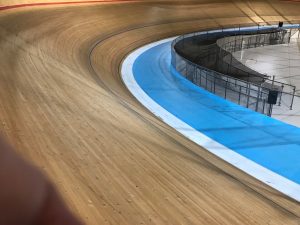
My indoor setup from the 2016 Masters Track Worlds CdA is 0.221. The best combination I tested – Cervelo T4 with Zipp wheels – lowered that to 0.211. At 34mph (indoor pursuit speed) this 0.010 CdA reduction saves 20 watts of power. For me, the projected time savings is 2.7 seconds over a 3k race. That’s more than all my testing improvements from last year put together! In a sport that rewards very small time differences, I’m very excited to roll out this new setup!
Future Resistance Testing
This is one of the more conclusive test sessions I have done, but there are still plenty of areas I’d like to test. I’ll likely revisit the USE Tula Track aerobar again with some different extension arrangements. Especially as a bigger rider, I’d like to split apart what part of the Zipp wheel savings may have been reduction in tire rolling resistance (Crr). You can pry Crr and CdA apart by testing at a range of speeds instead of just cruising speed. I ran the Mavic wheels at 200psi – the pressure used by everybody I talked to who tested them before on a super fast and smooth indoor velodrome track. I’d like to test running lower tire pressure and seeing what impact that may have on my Crr or CdA. That covers my most recent track testing. Stay tuned for Marty’s report for his Ironman triathlon setup aero testing.
Learn more about how to use a power meter as a wind tunnel and contact me to learn more about positioning and equipment aero testing.

